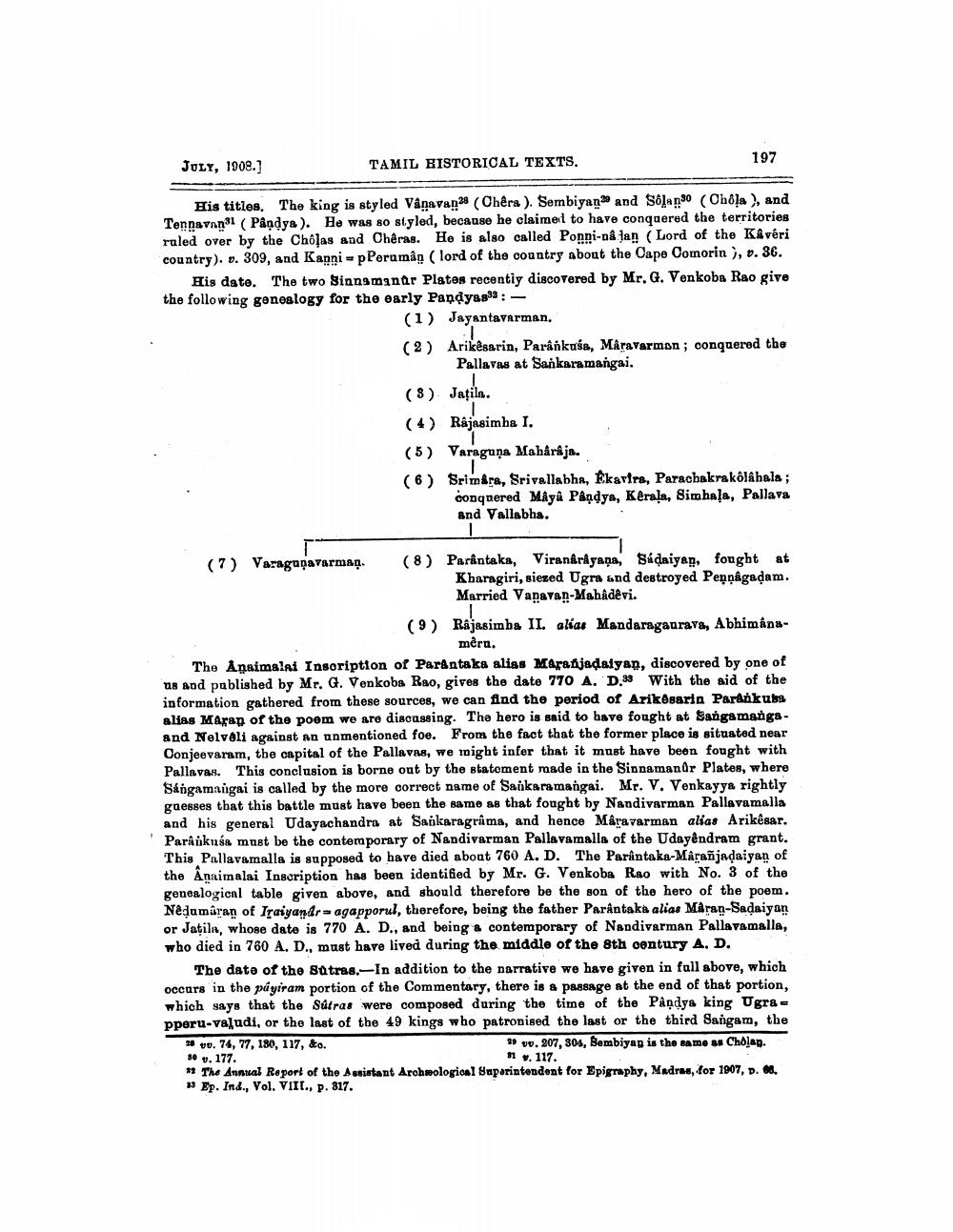________________
JULY, 1908.]
TAMIL BISTORICAL TEXTS,
197
His titles. The king is styled Vanavan (Chêra). Sembiyan and S630 (Ohola), and Tennavan (Pandya). He was so styled, because he claimed to have conquered the territories ruled over by the Cholas and Cheras. He is also called Ponni-nå Jan (Lord of the K&véri country). v. 309, and Kanni-pPeruman ( lord of the country about the Cape Comorin ), s. 36.
His date. The two Sinnemanar Plates recentiy discovered by Mr. G. Venkoba Rao give the following genealogy for the early Pandya998:
(1) Jayantavarman. (2) Arikêsarin, Paränkusa, Måra varmon; conquered the
Pallavas at Sankaramangai. (8) Jațila. (4) Rajasimha I. (5) Varaguņa Maharaja. (6) Srimara, Srivallabha, Ekavira, Parachakrakólahala ;
conquered Maya Pandya, Kerala, Simhala, Pallava and Vallabha.
(7) Varagu avarman. (8) Parântaka, Viranêriyaņa, Sidaiyan, fought at
Kharagiri, siezed Ugra and destroyed Peņnågadam.
Married Vanavan-Mahadevi. (9) Rajasimba II. alias Mandaragaurave, Abhimana
méra. The Annimali Insoription of Parantaka aligs Maranjadaiyan, discovered by one of us and pablished by Mr. G. Venkoba Rao, gives the date 770 A. D.33 With the aid of the information gathered from these sources, we can find the period of Arikosarin Parankubs alias Maran of the poom we are discussing. The hero is said to have fought at Sangamangaand Nelvoli against an anmentioned foe. From the fact that the former place is situated near Conjeevaram, the capital of the Pallavas, we might infer that it must have been fought with Pallavas. This conclusion is borne out by the statement made in the Sinnamandr Plates, where Sángamangai is called by the more correct name of Sankaramangai. Mr. V. Venkayya rightly guesses that this battle must have been the same as that fought by Nandivarman Pallavamalla and his general Udayachandra at Sankaragrâma, and hence Mâravarman alias Arikêsar. Paranknsa must be the contemporary of Nandivarman Pallavamalls of the Udayêndram grant. This Pallavamalla is supposed to have died about 760 A. D. The Parantaka-Marañjadaiyan of the Anaimalai Inscription has been identified by Mr. G. Venkoba Rao with No. 3 of the genealogical table given above, and should therefore be the son of the hero of the poem. Nedumâran of Iraiyandr - agapporul, therefore, being the father Parântaka alias Maran-Sadaiyan or Jatila, whose date is 770 A. D., and being & contemporary of Nandivarman Pallavamalla, who died in 760 A, D., must have lived during the middle of the 8th century A. D.
The date of the Stras. In addition to the narrative we have given in fall above, which occurs in the páyiram portion of the Commentary, there is a passage at the end of that portion, which says that the Sätras were composed during the time of the Påndya king Ugrapperu-valudi, or the last of the 49 kings who patronised the last or the third Sangam, the 2 vo. 74, 77, 180, 117, &o.
* vo. 207, 304, Bembiyap is the same as Cholap. 39 v. 177.
11 . 117. ** The Annual Report of the Assistant Archeological Superintendent for Epigraphy, Madras, for 1907, D. . » Ep. Ind., Vol. VIII., p. 317.




